 |
| Appomattox Court House Museum |
My interest was sparked a few years ago while reading Bill O'Reilly's "Killing Lincoln." In it, O'Reilly and co-author Martin Dugard cover the final days of the Confederacy, as well as, of course, the final days of President Lincoln (and his assassin, John Wilkes Booth).
 |
| Five Forks Visitor's Center |
It was a life or death chess match between Lee and Grant, as Grant and his huge army countered every Lee westward movement, until he checkmated him at Appomattox.
Along the way, there were battles with names such as Five Forks, Amelia Courthouse, Sailor's (or Saylor's) Creek and High Bridge.
 |
| Five Forks Battlefield Visitor's Center |
So after our Memorial Day visit with my parents in Virginia's Northern Neck (and my brother Pete, and other relatives- see this blog post for more on that), Alesia and I set out to trace the approximately 94 mile "Lee's Retreat" from Petersburg to Appomattox.
 |
| Along Highway 460 |
 |
| Markers like this depict what happened nearby as Lee retreated |
We chose to cover the 90-plus mile retreat route over two days, stopping overnight in Farmville, which is about 30 miles east of Appomattox.
 |
| Main entrance |
Pamplin is located in Dinwiddie County, not far from Petersburg. Since it is privately owned and not a federal or state facility, there is an entrance fee ($13 for adults). But it is worth it due to the quality and detail within the gates of this vast site.
 |
| Sign at Pamplin Park's entrance |
"April 2, 1865. Here the Union's 5th Army Corps broke through the Confederate line defending Petersburg, during a series of attacks which eventually led to the evacuation of the city by Lee's army that evening."
 |
| A.P. Hill death marker |
The sign's last line reads: "Nearby, Confederate General A.P. Hill was killed in the day's fighting."
The marker, which we made a point to locate outside the Pamplin park, reads as follows: "To the memory of A.P. Hill, Lt-Gen. C.S.A. He was killed about 600 yards northwardly from this marker, being shot by a small band of stragglers from the federal lines on the morning of April 2nd, 1865. Erected by the A.P. Hill Camps Sons of Confederate Veterans- Petersburg, Va."
There is a ground marker in the vicinity of these signs that claims to be the spot where Hill was killed. We didn't know to look for that marker.
 |
| A.P. Hill in a Pamplin park display |
Hill was a corps commander in Lee's Army of Northern Virginia at the time of his death. He was 39 years old.
The Pamplin Civil War site was a treasure to visit for the first time! It has only been around since the 1990s.
It has an interesting history of private development. It is named for Dr. Robert Pamplin, whose descendants owned and lived on these 400-plus acres during the war. He is credited with rescuing these important historic grounds from suburban development. Read more about the park's background here.
Pamplin's National Museum of the Civil War Soldier is excellent.
And we picked a good day to visit, the day after Memorial Day. We really only saw a handful of other people the entire 3-plus hours we were there.
On the museum's walls are large and elaborate murals depicting the daily lives of soldiers.
There are also displays of guns and other weaponry.
Visitors are given headsets to hear narrations to go along with the various points of interest along the museums halls and display rooms.
There is great attention to the often mundane soldiers' lives, and what they did to pass the time.
Visitors can also select from about a dozen Southern and Northern soldiers, to hear perspectives of a particular man, gleaned from actual diaries and other writings.
Some of these men survived the war, some didn't. You have to wait until the end of the tour to learn your "chaperone's" fate.
Soldiers who misbehaved or worse had to pay the consequences. That is shown and described in detail, as well.
One of the National Museum of the Civil War Soldiers neatest exhibits is a wooded area you walk through and are fired upon by Union troops.
It felt very realistic in conveying to some degree what combat must have been like.
This fallen soldier shown on the left moves and opens his eyes as you walk by. He gave a startling chill to both of us!
The big museum is just one part of Pamplin. Outside are many displays, including remains of the actual defensive positions the Confederates dug.
This replica trench and spiked defensive spears give a real sense of the trench warfare both sides endured (or died defending or attacking) around Petersburg during the 10-month Federal siege of the important transportation hub near Richmond in 1864-1865.
There are trails of various lengths (depending on your energy level and time to spend) that show in great detail the Confederate and Union troop positions and movements that culminated in the breakthrough that spelled doom to Lee's Army of Northern Virginia.
Rifle pits and trenches are marked throughout the battlefield.
It's amazing what Mr. Pamplin and all of his supporters, historians and other workers have done to preserve and interpret what had been a little-known and documented crucial final stage of the Civil War!
The information on the many displays along the trail are so specific. You are literally standing and seeing where it all happened, that crucial Union breakthrough of what had been impenetrable Confederate fortifications.
Here is the spot where determined Vermont troops made the vital first penetration of the Confederate lines.
I learned that over time there were many Union units that claimed credit for the initial breakthrough here. Pamplin seems to go with Vermonters on this matter.
"A determination that knew no such word as fail" is the headline on this marker describing the bravery and tenacity of the men from Vermont.
I would learn about the important contributions a South Carolina man made to the Confederate fortifications that had held strong for so long in this region.
Brig. Gen. Samuel McGowan was a lawyer from Abbeville, S.C. who here commanded five regiments of some 1,400 men from the Palmetto State. McGowan, who commanded a brigade in Gen. A.P. Hill's corps, was responsible for maintaining these fortifications from October 1864 until the Federals broke through in early April 1865.
McGowan, who was wounded at Chancellorsville and Spotsylvania, and his staff occupied this plantation house, which is part of the Pamplin park and open to visit.
The house displays excel in illustrating the Civil War lives here of McGowan and his staff who lived and worked here, and the family that found themselves dangerously part of the war.
A true touch of South Carolina is seen on this hat on the fireplace mantle.
Lots of officers shared this bedroom.
The lives of Mr. Pamplin's ancestors are depicted in the house, along with the Confederate soldiers' representation- an interesting mix.
An image of Confederate cavalry commander Gen. Jeb Stuart hangs in a room.
Stuart would not be part of Lee's retreat, having been killed at Yellow Tavern in 1864.
Along with the restored plantation house, Pamplin features other buildings that would have been part of a prosperous plantation in the 1800s.
This is a tobacco curing barn....
...with rows of the valuable cash crop inside.
Pamplin Park offers a complete Civil War education experience, with some hands-on fun too.
Kids, big and small, will enjoy what's inside this small structure. Drums, guns and soldiers' uniforms are there to play with and try on.
This was a nice touch outside the main entrance to Pamplin.
Every state, North and South, is represented with the number of men who served in the military and how many died during the war.
For South Carolina, the number given is 80,462 who served and 17,682 who died.
For such a small population state compared to the others, South Carolina contributed heavily proportionally in manpower- and bloodshed.
Pamplin Historical Park receives five stars from this first time visitor!
I have in the past been to the main Petersburg battlefield. I never knew about Pamplin until preparing for this trip.
Now I am glad this was the first stop of the day, because we did spend a lot of time at Pamplin and felt like we did see everything to see there.
If you do go, don't be in a hurry. There is so much to see both inside the main museum and a smaller second one.
And you'll want to take your time to explore the plantation house and outer buildings, and to walk the trails that show and explain what happened here that was so significant in bringing the long war to a rather sudden end, after this breakthrough battle.
After departing Pamplin Park, we began our search for the "Lee's Retreat" route.
Signage for the little known White Oak Road Battlefield was the first marker we came upon.
This engagement took place before the crucial Union "breakthrough battle" on April 2.
Not too much to see here other than these two signs. I think there was a walking trail too, but we opted to skip that, being a bit tired after the hours spent at Pamplin.
Our plan was to spend the night in Farmville, which is about 60 miles west of Petersburg. So we had a leisurely drive through lovely Virginia countryside.
Five Forks was among the spots I wanted to see. This was one of the last major battles between Lee and Grant's army.
At this junction of five roads, one can see why the area is called Five Forks. And it was pretty cool that this is the actual intersection that was of strategic importance to both armies.
A marker at the crossing, erected in 1965, 100 years after the battle, explains what happened here on April 1, 1865: "Ten thousand Confederates, commanded by General George Pickett, were overwhelmed by about 50,000 federal troops led by General Sheridan, thereby opening the way to the Southside Railroad making further defense of Petersburg and Richmond impossible. Withdrawal to Appomattox followed."
The Union force surprised the Confederates with their afternoon attack. Gen. Pickett would receive great criticism for being away from his men to participate in a shad lunch miles away.
Robert E. Lee was so upset with Pickett that he removed him from command. But apparently Pickett did not receive word of Lee's removal of him. Pickett would continue with this troops to the bitter end at Appomattox.
Union Gen. Gouverneur Warren would also be removed from his command after this battle by Gen. Phillip Sheridan, who, on this Five Forks marker, is shown charging the rebel defenses.
The Five Forks battlefield has a small information center. It is remotely located in rural Dinwiddie County.
Near this center is a walking trail showing various troop positions and remains of Southern defensive trenches.
The center has a small collection of historic and period pieces, including this plastic horse on loan from another museum, the ranger there told us.
A short video can be viewed, which was excellent in putting Five Forks in context and preparing us more for the days to follow as Lee and his Army of Northern Virginia moved west in hopes of joining Gen. Joseph E. Johnston's Confederate army in North Carolina, in order to continue the war.
But Grant would not allow that to happen.
Blocking roads and disrupting rail lines used to support Lee's army were a big part of Grant's strategy.
Along Lee's Retreat, there are many small stopping points like this one at Ford's Depot.
There is room at each stop to safely pull over the car and read and see what happened nearby.
It's interesting to try to envision the action that took place while standing on the very spot, or near, where it actually did.
The history here at Ford's Depot sunk in after reading the sign information and stopping for a minute to look at the railroad tracks that in June 1864 were attacked and mangled by Union raiders.
"Destruction of ties, rails, culverts and bridges began in earnest," according to a member of the 5th New York Cavalry, as shared on the Ford's Depot sign.
On the heels of the bad Confederate defeat at Five Fork's, Sailor's Creek, just a few days later, would be, to use the cliche, the straw that broke the camel's back.
The Sailor's Creek Battlefield is a sprawling, well-marked and maintained site that encompasses parts of three rural Virginia counties: Amelia, Prince Edward and Nottoway.
This old marker that dates to 1928 concisely sums up Sailor's Creek's significance: "Here Lee fought his last battle. April 6, 1865. Ewell almost won a great victory but was overwhelmed by Sheridan."
Ewell, in fact would surrender his force here. The Union captured thousands of other Confederates here. And many Southerners saw the writing on the wall and just walked away from Lee's army.
The house seen behind this sign still has bullet holes from the fierce fighting that took place in this area.
The house is occupied today. I suppose the residents are used to folks stopping and trying to see the war scars.
We didn't see any residents when we were there. I think it's admirable that they have kept these bullet holes and are OK with people stopping, looking and taking pictures, as we did.
Sailor's Creek has a really nice visitor's center, which we didn't get to spend too much time exploring because it closes at 5 p.m. and we didn't get there until about 4:45.
Sailor's Creek, as I learned, consisted of three different battles over a sprawling three county area, as a I said earlier.
Sailor's Creek was definitely a Civil War site I wanted to visit, knowing that it was such a devastating loss for Lee and his army. Just three days later he would surrender at Appomattox.
My only regret on this trip was not getting to a couple other pivotal places along Lee's Retreat, one of them being Amelia Courthouse.
This was where Lee had expected to resupply his weary army, but that did not occur. A battle took place on April 5, the day prior to the decisive Sailor's Creek route of Lee's army.
Amelia Courthouse and a few other important places are along a highway other than 460, which I mostly stayed on.
But I'm not too disappointed. Between the two battlefields, I'd still take Sailor's Creek (shown in this mural at the center there) over Amelia Court House.
There's always next time, right? We'll get to Amelia and some of those other sites in the future, hopefully.
I was most appreciative of the extra daylight that springtime offers.
Sailor's Creek was very interesting and the driving tour featured many signs like this one.
This drawing of surrendering Southerners, seen the next day at the museum at Appomattox Courthouse concisely summed things up: "The Battle of Sailor's Creek was the Confederacy's most serious loss during the retreat to Appomattox. The Army of Northern Virginia lost eight generals and 7,700 men."
Lee was running out of moves after this battle.
Soon Grant would offer surrender terms.
This broken down transport, whether for cannon or wagon, was near the Double Bridge sign shown above.
No signage indicated the story behind it. Chains keep it from being stolen.
Today, as it was back then during the war, this central Virginia region was rich in agriculture.
It was fun and relaxing to see these quiet and open areas with so much green grass and beautiful trees.
Tobacco was big in Virginia back in the 18th and 19th centuries. We didn't see any of that where we went, but did see lots of hay like you see here.
I feel like the timing (late May) was perfect for this adventure. It was warm but not excessively hot and humid.
Before we went into Farmville and our hotel for the night, there was one more place I was determined to find along Lee's Retreat path.
The Battle of High Bridge, really two battles, was fought on April 6-7, 1865 The massive span crosses the Appomattox River near Farmville and Lee needed to cross it.
The Union wanted to destroy it to block Lee's exodus, and the Confederates could not let that happen.
Today, High Bridge is only for walking, not for trains, specifically the South Side Railroad, as it was back then.
The remains can be seen of the massive columns that held the railroad tracks. There was a wooden bridge nearby that was for wagons. I saw no signs of that span.
At Sailor's Creek Battlefield's visitor's center is this image of the impressive High Bridge as it looked in 1865.
Completed in 1854, High Bridge was a marvel of its time, standing 125 feet high and extending 2,400 feet.
 |
| Alesia strolls on High Bridge near Farmville |
Today, High Bridge (once you find it- not easy!) is a really neat place to walk across.
The Appomattox River is not very wide at this point.
From this vantage point can be seen the old trestle. Twenty one brick piers supported the train tracks.
Here is another link to the history of High Bridge that includes a few photographs from the 19th century.
I photographed these birds atop High Bridge. Originally, I thought they were crows, but turns out, via my go-to bird identifications site, whatbird.com, they are Common Ravens.
More of my Virginia birds can be seen here.
High Bridge was a place I am so glad to have seen on this trip.
Billed as "36 Hours Before Appomattox" this is a must see when doing a "Lee Retreat" journey.
Farmville was a pleasant place to stop for the night. The Hampton Inn was very comfortable and included a really good breakfast to help us get started on the final stretch of our trip.
That night, we had a delicious dinner at Charley's Waterfront Cafe.
In Farmville, I wanted to check out this Confederate Cemetery. It wasn't what I expected.
Instead of a regular cemetery, it consisted only of a neatly landscaped area with this marker that memorializes "hundreds of men interred here after dying in the Farmville Confederate Hospital 1862-1865."
The marker was dedicated just a few years ago as part of the local Civil War sesquicentennial remembrance.
By mid-morning we were back on the road following the last stretch of "Lee's Retreat" to Appomattox.
There was more beautiful scenery to take in....
---and several stops to make to absorb more historical information about what, by now, was just hours until the Appomattox surrender.
This story at Clifton about Grant's "sick headache" indicated the stress felt by the Union commander who by this point knew it was not if end was near for Lee, but when.
Alas, we had made it to Appomattox County!
We began to see more "last" and "final" signs and depictions. This site told us we were near Lee's last headquarters.
This sign on the outskirts of the small community of Appomattox Court House states: "Near this spot stood the apple tree under which Gen. Robert E. Lee rested while awaiting the return of a flag of truce sent to him by Gen. U.S. Grant on the morning of April 9, 1865."
This is where Lee and Grant would meet to work out the surrender terms.
This was considered the finest house in the small hamlet, so this is where a Lee adjutant arranged for the meeting to be held.
The house was the home of Wilmer McLean and his family. They, ironically, moved here from their farm where the Civil War's first major battle took place: Bull Run (or Manassas).
The war started with them and ended with them!
This is a post-war photo of the McLean family and their house that would become so famous (and vandalized by Union troops after the surrender).
The family would move back to Northern Virginia in 1867 and then would lose possession of what became known as the "surrender house" after Wilmer McLean defaulted on loan payments.
The National Park Service operates the historic Appomattox surrender site. Admission is free and guides are very friendly and well informed about the history here.
Visitors can go inside and see both the first and second floors.
This panorama I took with my iPhone could be considered, I guess, the "money shot" for this is the room where the two generals met. Lee sat at the table on the left and Grant at the one on the right. Assorted generals and other officers filled the modest sized room.
The museum near the McLean House is excellent. Among its displays are several paintings of the surrender showing men who in truth were there and some who were not.
A restored depiction of a McLean House bedroom.
The McLean family was prosperous in this tiny farming community, as reflected in this restored dining room.
Grant and Lee confer in this image located in the Appomattox Court House museum.
There are several other buildings to explore along with the McLean House. This is a slave home.
Outside, this is the grave site of a young man from Appomattox who died early in the war in Fairfax Court House, Va.
A small Confederate cemetery near the McLean House.
Four bloody years of war finally came to an end on April 9, 1865- at least for the two main forces battling in Virginia.
Confederate armies elsewhere in the South
would surrender in the days and weeks ahead.
The guns finally were silent.
We found another South Carolina connection in this display.
The young Confederate officer shown on the right, Major John Cheves Haskell, 23, of Columbia, was placed in charge of surrendering the Army of Northern Virginia's artillery.
Haskell, who was one armed, had six brothers who also served in the Confederate army, two of whom died in the war.
Haskell, as stated in the display, had kind words for how he and his men were treated by his Union counterpart during the surrender proceedings. This display did not say how he lost his arm.
After completing our visit to the Appomattox Court House complex, we drove a few miles to the town of Appomattox.
Appomattox is a small, clean, bustling town.
Alesia and I would enjoy a very good quiche lunch at Baine's Books and Coffee on Main Street. Then it was time to begin our long drive back to Charleston, which would take 8-9 hours.
It was an interesting drive back, through parts of Virginia, North and South Carolina we had not seen before.
We accomplished our "Lee's Retreat" tour.
It will be a cherished memory forever!



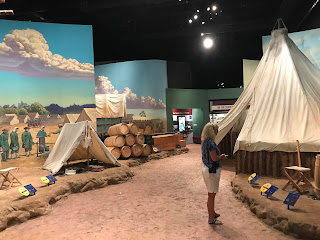
































































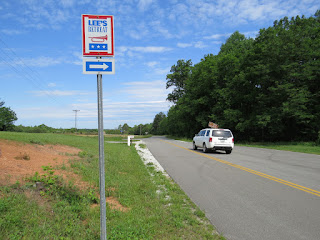









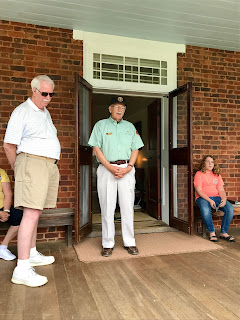













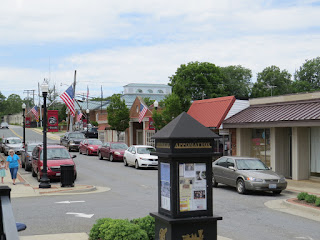
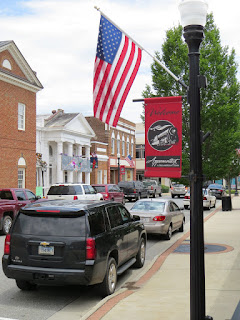

No comments:
Post a Comment